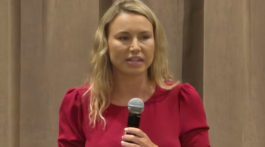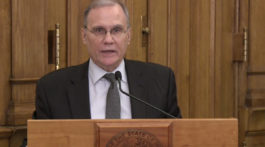by Chris Watts
The opening days of the Indiana General Assembly saw lawmakers adjusting to staying apart while working together on issues like COVID protections and criminal justice reform. But the defining business of this session – passing a new state budget – really got underway Wednesday. Governor Holcomb released his budget blueprint, introduced with minor changes in the House.
The headline was obvious: House Bill 1001 boosts K-12 expenditures by 2% in 2022 and another 1% for 2023, adding $377 million in state aid to schools over the next budget cycle. Altogether, K-12 accounts for nearly $18 billion of the more than $35 billion in proposed biennial spending.
But there’s plenty of work to be done before the budget earns a passing grade. In addition to overall funding levels, here are a few key issues to watch as the process moves forward:
Down for the count?
Legislators are acting quickly to fix an existing state law that assigns less funding for students educated online (which obviously didn’t anticipate the widespread shift to remote learning during the pandemic). But another issue looms – the total number of Hoosier students, virtual or in-person.
In Indiana, most state funding follows the student; districts receive monthly allocations based on fall and spring enrollment counts (Average Daily Membership, or ADM counts). But COVID has impacted enrollment: 15,000 fewer students were attending Indiana public schools during the September ADM count, a combination of parents delaying enrolling kindergarteners, homeschooling or choosing other alternatives in reaction to the public health crisis.
This data is used for projections of per-student funding within the overall budget. But how quickly will numbers rebound? Will enrollment shifts persist even after widespread vaccinations? COVID-influenced assumptions about student populations may prove irrelevant by 2023, casting uncertainty over school budgets. Keep an eye on the February count as a milestone in the funding policy debate.
Pay it forward:
When a district’s enrollment drops, so does its state funding. September’s decline was unusually sharp and statewide, leaving districts struggling to fill budget gaps while often dealing with shifts in remote versus in-person learning. By law, unused education appropriations go back into the state’s general fund – so the low September ADM could put $100+ million meant for schools into the state surplus instead.
Because of the unusual circumstances and the strain on K-12 through the pandemic, there’s a push to pull this money forward into the new budget. (For context, the available resources could more than double the $75 million earmarked for Teacher Appreciation Grants, which go directly to teacher pay.)
For another option, HB1008 creates a Student Learning Recovery Grant program to combat learning losses suffered by students through COVID. The language of the bill references general fund resources this fiscal year, which could mean effectively recapturing the education reversion. The move would help address immediate challenges while maximizing revenues available for tuition support in 2022 and 2023.
Dividing the dollars:
Speaking of tuition support, per-student funding isn’t simply a flat amount. Money is added for students requiring special education, or English-as-a-second-language coursework. Then there’s the ‘complexity grant’ – funding targeted to low-income students, recognizing the disparities in educational opportunities created by family resources.
Achievement gaps are likely widened by the pandemic. Households that can’t afford high-speed Internet, where adults don’t have the flexibility to supervise e-learning or the luxury of investing in a neighborhood learning pod, run the risk of falling further behind during this year of disrupted education. So complexity could be even more important in this budget as schools strive for normalcy.
Complexity is assigned through a formula that includes free-and-reduced lunch eligibility, household participation in federal poverty programs (like SNAP and TANF) and more. Because the pandemic impacted local economies differently, the next budget could see district-by-district changes in complexity (continuing to play the most crucial role in the budgets of urban school corporations like IPS).
Complexity funding was a key difference between House and Senate budget negotiators in 2019, and is shaping up to be even more important this year as school districts grapple with the economic hardships created by COVID (and fierce competition for available resources).
Turning away from the state budget, there’s another set of policy debates on local school revenues – charter schools seeking to share in property tax referenda, changes that would ease limits on tax levies in growing communities, push local income taxes to more school districts, and more. HB1001 is the main event, but these proposals could make a longer-term impact beyond this biennium.
In short, this week’s ‘first draft’ of the budget featured some attention-grabbing spending totals for K-12 education. But to sound like a stickler middle-school math teacher, now it’s time for legislators to “show their work:” The calculations get more complicated as we clarify how these numbers translate to the bottom lines of local schools, teacher paychecks and student learning opportunities.
Chris Watts is the head of the non-partisan Indiana Fiscal Policy Institute.














